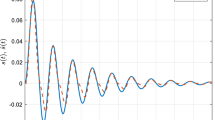This paper analyzes the solution to fully fuzzy linear systems (FFLS). To do so, the implicit Gauss–Cholesky algorithm (IGC) of ABS class is used. Indeed FFLS with different right hand-sides are considered.
Similar content being viewed by others
References
J. Abaffy and E. Spedicato, The ABS Projection Algorithm: Mathematical Techniques for Linear and Non-Linear Systems, Ellis Horwood, Chichester, UK (1989).
J. Abaffy, M. Bertocchi, and A. Torriero, “Perturbations of M-matrices via ABS methods and its application to input–output analysis,” Appl. Math. Comput., 94, 145–170 (1998).
S. Abbasbandy, R. Ezzati, and A. Jafarian, “LU decomposition method for solving fuzzy system of linear equations,” Appl. Math. Comput., 172, 633–643 (2006).
S. Abbasbandy, M. Otadi, and M. Mosleh, “Minimal solution of general dual fuzzy linear systems,” Chaos, Solitons and Fractals, 37, 1113–1124 (2008).
T. Allahviranloo, N. A. Kiani, M. Barkhordary, and M. Mosleh, “Homomorphic solution of fully fuzzy linear systems,” Comput. Math. Model., 19, 282–291 (2008).
K. Amini, N. Mahdavi-Amiri, and M. R. Peyghami, “Extended reduced rank two Abaffian update schemes in the ABS-type methods,” Appl. Math. Comput., 185, 255–265 (2007).
M. Dehghan, B. Hashemi, and M. Ghatee, “Computational methods for solving fully fuzzy linear systems,” Appl. Math. Comput., 179, 328–343 (2006).
M. Dehghan, B. Hashemi, and M. Ghatee, “Solution of the fully fuzzy linear systems using iterative techniques,” Chaos, Solitons and Fractals, 34, 316–336 (2007).
D. Dubois and H. Prade, “Systems of linear fuzzy constraints,” Fuzzy Sets Syst., 3, 37–48 (1980).
D. Dubois and H. Prade, Fuzzy Sets and Systems: Theory and Applications, Academic Press, New York (1980).
M. Friedman, M. Ming, and A. Kandel, “Fuzzy linear systems,” Fuzzy Sets Syst., 96, 201–209 (1998).
E. E. Kerre, Fuzzy Sets and Approximate Reasoning, Xian Jiaotong University Press, Xian, People’s Republic of China (1999).
L.-P. Pang, E. Spedicato, Z.-Q. Xia, and W. Wang, “A method for solving the system of linear equations and linear inequalities,” Math. Comput. Modelling, 46, 823–836 (2007).
S. N. Sivanandam, S. Sumathi, and S. N. Deepa, Introduction to Fuzzy Logic Using MATLAB, Springer, Berlin–Heidelberg (2007).
L. Stefanini, L. Sorini, and G. M. Letizia, “Simulation of fuzzy dynamical systems using the LU-representation of fuzzy numbers,” Chaos, Solitons and Fractals, 29, 638–652 (2006).
Author information
Authors and Affiliations
Corresponding author
Rights and permissions
About this article
Cite this article
Abbasbandy, S., Hashemi, M.S. Solving fully fuzzy linear systems by using implicit Gauss–Cholesky algorithm. Comput Math Model 23, 107–124 (2012). https://doi.org/10.1007/s10598-012-9123-4
Published:
Issue Date:
DOI: https://doi.org/10.1007/s10598-012-9123-4



